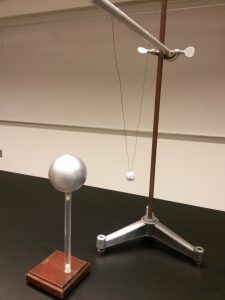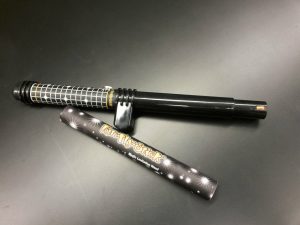Coulomb’s Law
In this lab you will put an excess electric charge on a metal sphere and a small aluminum foil ball and study and measure the force between the two objects.
Objectives
- Show that there is a repulsive force between two objects with excess charge of the same sign
- Verify the inverse-square law for force between electric charges
Resources
 Metal sphere mounted on a non-conductive stand
Metal sphere mounted on a non-conductive stand- Small aluminum foil ball hanging on a string
- Mini Van de Graaff generator (“Fun Fly Stick”)
- Digital camera (or cell phone)
- Computer with very simple image analysis software (e.g. MS Paint)
The force between any two charges q_1 and q_2 separated by a distance r is given by Coulomb’s Law F=k\frac{q_1q_2}{r^2}
where k=8.987\times 10^9 \mathrm{\ N \cdot m^2 \cdot C^{-2}} is Coulomb’s constant. Excess charge on the surface of a sphere will spread out evenly as each charge tries to move away from the others, and for points outside the sphere the force will be the same as if all this charge were concentrated at the center of the sphere.
Guideposts/Hints:
 You can use the Fun Fly Stick to apply an excess charge to a conductive object by touching the object with the metal tab at the end of the stick while pressing the activator button.
You can use the Fun Fly Stick to apply an excess charge to a conductive object by touching the object with the metal tab at the end of the stick while pressing the activator button.- The force acting horizontally upon a hanging object can be determined by the angle at which the string hangs. What forces are acting upon the negatively charged aluminum foil ball if a negatively charged sphere is brought near it?
- There is no practical way to measure the actual quantity of charge on the foil ball or the metal sphere, so you cannot calculate the numerical value of the electrical force. You don’t need this, however, since your goal is to find the power-law relationship between the electrical force and the separation distance between the charged objects.
Reminders
- Always estimate uncertainties in your measurements!
- Record all your data in a safe place so you/others can review it later. A
lab notebook is useful for this.